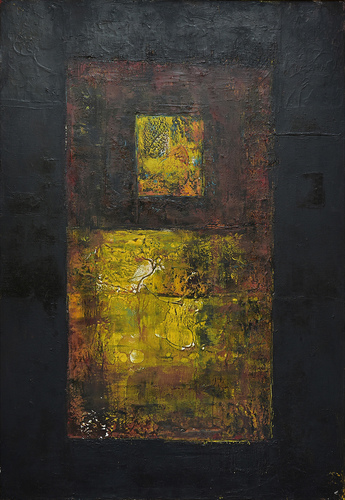-
From Current Issue
-
- Editor’s Letter Fire in the Heart
- Reviews I Gusti Ayu Kadek Murniasih
- Reviews 11th Seoul Mediacity Biennale: “One Escape at a Time”
- Dispatch Networked China
- One on One Monira Al Qadiri on Yukio Mishima
- Essays The rise of independent art spaces in pandemic-era Shanghai
- Features Tuan Andrew Nguyen
- Table of Contents
- Web Exclusives
- Archive
- Subscribe

R
E
V N
E
X
T
Installation view of “Sensation” at CAMA Gallery, London, 2018. All images courtesy the artists and CAMA Gallery, London/Tehran.
This April saw the opening of CAMA Gallery— London’s first institution to feature exclusively Iranian art, and the offshoot of the established Tehran-based gallery of the same name—with “Sensation,” an inaugural exhibition of 51 works by a variety of artists hailing from the Middle Eastern country, which has enjoyed growing demand for its art both at home and abroad over the past few years.
The inescapably prominent painting that visitors would likely notice first on entering the gallery was Fereydoon Omidi’s UK (2014), a giant Union Jack painted in oils that, initially, seems a baffling curatorial choice. At a time of heightened nationalist feeling in the United Kingdom, and with the ostensibly benign, soft-power-driven superficiality of “Cool Britannia” firmly and fortunately in the past, this selection from Omidi’s “Flags” series made for a jarring welcome. As it happens, though, the painting itself was not the problem. Adequately lit, UK reveals an array of Persian calligraphic marks—as do many of the artist’s canvases—which would have diffused this unsettling first impression with an interpretation that evades British jingoism. Without suggesting the ascendency of the white cube, CAMA’s light-absorbing grey walls and matt black floors did not help the matter.
Placing the issue of lighting to one side, the exhibition was otherwise well put together, with the various tight spaces of the gallery’s basement rooms put to good use and allowing for some works to be viewed from different ranges. This was especially important for pieces such as Babak Roshaninejad’s Left Face No. 2 and 3 (both 2013), the banality of whose realistic and monochromatic portraits of women’s faces cedes to an engagingly broad impasto when viewed up close; and Niloufar Ghaderinezhad’s Anahita (2017), in which what appear as harmoniously abstract forms when seen at a distance lend aesthetic force to what might otherwise be slightly muddled compositions of animals fighting.
Among the other works, many were given to a technically impressive but somewhat soulless proficiency, with several notable exceptions. Elham Yazdanian’s No. 3 (2017) and No. 4 (2013) are effective forays into the dynamics of light as it acts on the cracks and corners of the gloomy, semi-abstracted spaces depicted, while the multi-toned squares within squares of Fatemeh Divandari’s Untitled (2009), Gabbeh (2011) and Rug (2012) masterfully combined the aesthetic painterly sensibilities of an abstract expressionist with elements that subtly recall some of the great schools of Persian miniature painting. Within the window-like frame of Untitled, the strongest of these three works, in which variously textured black, brown and yellow planes sit on top of each other, Divandari achieves a complex abstract spatiality recalling at once Mark Rothko’s experiments in depth and the compact mise-en-scène of a 14th Century Tabriz School miniature.
Evoking other schools in the history of Persian miniaturism that were less concerned with perspective and space than the Tabriz, a number of acrylic paintings by Najva Erfani used almost flat compositions of symbolic elements and characters to reflect mythological scenes drawn from pre-Islamic Middle-Eastern religion and myth. In two untitled works from 2015 and 2016, half-familiar creatures painted with the use of light and shadow coexist with each other on the same monotone planes as bright, block-color vines and implicitly three-dimensional geometric forms that spread from the scenes’ central figures into the foreground like organically growing diamonds. The characters, impassive and often in profile, give the impression of the indifferent gods seen in ancient art.
In another set of works that both physically and visibly extend beyond the surface of the painting rather than concerning themselves with what lies behind it, Bita Vakili’s oneiric mixed-media cityscapes stretch out across the canvas like something between a distant nebula and a proliferation of cells beneath a microscope. On closer inspection, however, the towers sprouting into three-dimensional space from the plumes that cross the untitled works of Vakili’s “Shahrivar” series are made from something altogether more mundane: stacks of unused staples.
Although some of the works in “Sensation” were more plainly competent than formally interesting, and many of the better pieces were often let down by insufficient lighting, such problems can carry silver linings. Forced to view these works from a variety of compensatory angles, a wealth of detail appears below, on and above the surface.
Ned Carter Miles is the London desk editor of ArtAsiaPacific.
“Sensation” is on view at CAMA Gallery, London, until June 20, 2018.
To read more of ArtAsiaPacific’s articles, visit our Digital Library.







